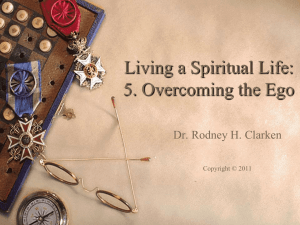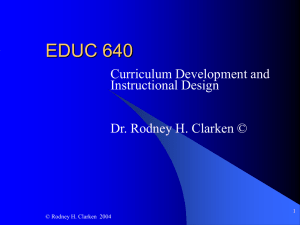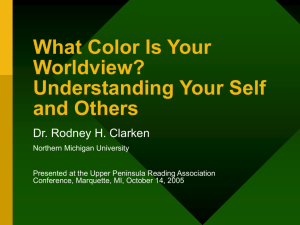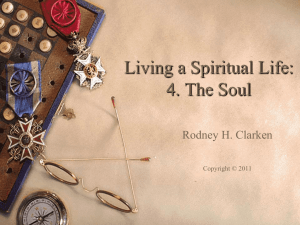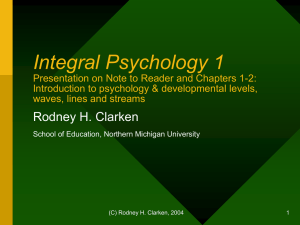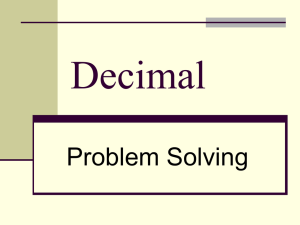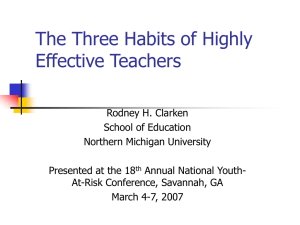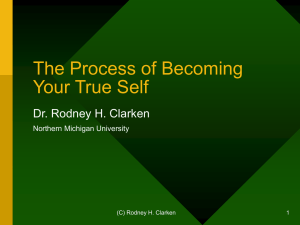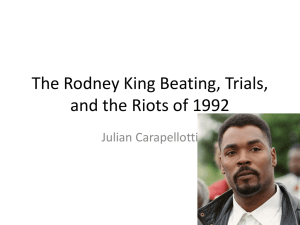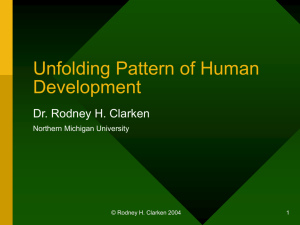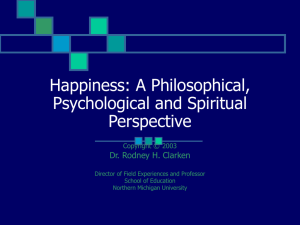Integral Psychology 5: Some Developmental Lines
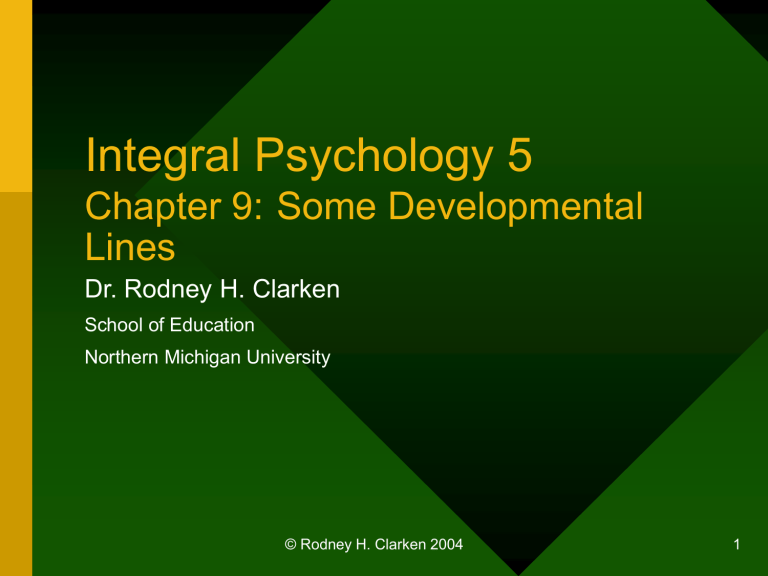
Integral Psychology 5
Chapter 9: Some Developmental
Lines
Dr. Rodney H. Clarken
School of Education
Northern Michigan University
© Rodney H. Clarken 2004 1
This presentation is my attempt to summarize
Chapter 9,
• of Ken Wilber’s Integral Psychology, published in 2000 , pp. 115-128 .
• I recommend you view the earlier presentations in this series and read
Integral Psychology for a more complete and in depth understanding of the content.
© Rodney H. Clarken 2004 2
Levels of development: self sense: worldview
• Sensorimotor: material: archaic
• Emotional: body-ego: magical
• Representational &
Rule/role mind: persona: mythic
• Formal-reflexive: ego: rational
• Vision-logic: body-mind: existential
• Psychic & Subtle: soul: divine
• Causal & nondual: spirit: one Spirit
© Rodney H. Clarken 2004 3
All developmental lines
• Are variations on the three irreducible modes: aesthetic (subjective, I, UL), moral
(intersubjective, we, LL) and scientific
(objective, it/s, UR, LR)
• Subjective: e.g., self identity, affects, needs, aesthetics
• Intersubjective: worldviews, linguistics, ethics
• Objective: scientific cognition
© Rodney H. Clarken 2004 4
Consciousness
• Arises within the clearing created by culture
• Subjectivity and intersubjectivity are mutually arising and interdependent
• What you think is controlled by level of development of individual and collective
© Rodney H. Clarken 2004 5
Affect, emotions, feelings
• Energetic feeling tone of each level
• Consciousness is more a feeling awareness than a thinking awareness
• Love is the foundation for and primary force behind all emotions
© Rodney H. Clarken 2004 6
Levels of affect
• Reactivity, sensations: touch, temperature, pleasure, pain
• Impulse: tension, fear, rage, satisfaction
• L2: anxiety, anger, wishing, liking, safety
• L3: love, joy, depression, hate, belongingness
© Rodney H. Clarken 2004 7
Levels of affect, cont.
• L4: universal affect, global justice, care, compassion, all-human love, worldcentric altruism
• Awe, rapture, compassion
• Ecstasy, love-bliss, saintly commitment
• Infinite freedom-release, one taste
© Rodney H. Clarken 2004 8
Levels of need, drive or motivation: “food”
• Physical: food, water, warmth, labor
• Biological/emotional: breath, sex, elan vital
• Mental: communication, symbols and units of meaning
• Spiritual: virtues, relationship with Source
© Rodney H. Clarken 2004 9
Relational Exchanges
• Each level needs to be in a relational exchange
• Oppression and repression distort exchanges, resulting in pathology
• All genuine needs reflect the interrelationships necessary for life at that level
© Rodney H. Clarken 2004 10
Maslow’s needs hierarchy
• Survival, physiological
• Safety
• Social, belongingness
• Self-esteem
• Self-actualization
• Self-transcendence
© Rodney H. Clarken 2004 11
Morals
• Includes principles of moral judgment
(how one reaches a moral decision) and moral span (those deemed worthy of consideration)
• You treat as yourself those with whom you identify; it expands as you develop from me to us (family, friends, community, nation) to all of us (humanity)
© Rodney H. Clarken 2004 12
Moral span
• Preconventional: egocentric, narcissistic,
“me”, locus of bodily self,
• Conventional: sociocentric, conformist,
“us”, locus of mythic-membership
• Postconventional: world centric, universal, “all of us”, locus of rational universal pluralism
© Rodney H. Clarken 2004 13
Creativity
• Part of human nature and the Kosmos: will
• Eros: the self-transcending pull or allurement of the Kosmos, Spirit-in-Action
• Drives emergences of higher and wider holons, an expansion of identity
© Rodney H. Clarken 2004 14
Gender Identity
• Undifferentiated
• Differentiated, basic gender identity, biological givens
• Conventional identity, cultural constructions
• Trans differentiated, gender androgyny
© Rodney H. Clarken 2004 15
Gender
• Deep features of development and self stages are gender neutral
• However, men tend to develop with and emphasis on agency (being in action) and women on communion (being in relationship), though both use both
© Rodney H. Clarken 2004 16
Aesthetics
• You can analyze any activity, such as art, on the level it comes from (subject, self) and the level it aims at (object, reality)
• For example, art produced by the mental level can take as its object something in the material, mental or spiritual realms
• This dual analysis can be done with all modes of consciousness
© Rodney H. Clarken 2004 17
Dual analysis
• Rationality can take as its object the sensorimotor realms, producing empiricalanalytical knowledge, the mental realms, producing phenomenology and hermeneutics, or the spiritual realm, producing theology
• With modernity, very high levels (reason) confined their attention to very low realms
(matter)
© Rodney H. Clarken 2004 18
Art levels
• Sensorimotor
• Emotionalexpressivist
• Magical imagery: cave art, surrealist
• Mythological-literal: religious, icons
© Rodney H. Clarken 2004
• Perspectival: naturalistic
• Aperspectival: cubist abstract
• Symbolist: fantastic
• Archetypal
19
Gross Cognition
• Takes as its object the sensorimotor realm, matter
• Begins with sensorimotor development, moves to preoperational, then to concrete operational to formal operational where it begins taking the world of thought as its object
© Rodney H. Clarken 2004 20
Subtle cognition
• Takes as its object the world of thought
• A distinctive developmental line from gross cognitions that goes through similar stages
• Begins in infancy with imagination, reverie, daydreams, creative visions, transcendental illuminations and thoughts
© Rodney H. Clarken 2004 21
Causal cognition
• The root of attention, the capacity for
Witnessing, equanimity, integration
• Can be traced to infancy, but cones increasingly to the fore in the post formal stages of development in psychic vision, subtle archetype and meditative states
© Rodney H. Clarken 2004 22
Different lines of the self
• Like cognition, self has three realms that develop relatively independently:
• 1. Gross self: ego, frontal
• 2. Subtle self: soul, deeper psychic
• 3. Casual self: Spirit, Witness
© Rodney H. Clarken 2004 23
Integral Psychology
• Involves waves (levels), streams (lines), and states (ego, soul and spirit)
• Center of gravity of self moves by the force of Love through all stages, from body to mind to soul to spirit, with concerns of the lower fading from immediacy while the higher move to the foreground
© Rodney H. Clarken 2004 24
Integral therapy
• Works concurrently with ego, soul and spirit as they unfold along side each other, carrying their own truths, insights and possible pathologies, recognizing and strengthening the soul and spirit as they emerge
• Integrate higher and lower domains into a full-spectrum realization
© Rodney H. Clarken 2004 25
References
• Most of the material in this presentation was taken from Chapter 9 of Ken
Wilber’s Integral Psychology, (2000), pp.
115-128.
© Rodney H. Clarken 2004 26
Contact information
Dr. Rodney H. Clarken
Director of Field Experiences and Professor
School of Education, Northern Michigan University,
1401 Presque Isle Avenue, Marquette, MI 49855-
5348
Tel: 906-227-2160 (secretary), 227-1881 (office), 226-
2079 (home), Fax: 227-2764, email: rclarken@nmu.edu
Website with this presentation and web cast and info on courses, papers, Baha'i and China: http://wwwinstruct.nmu.edu/education/rclarken
© Rodney H. Clarken 2004 27

